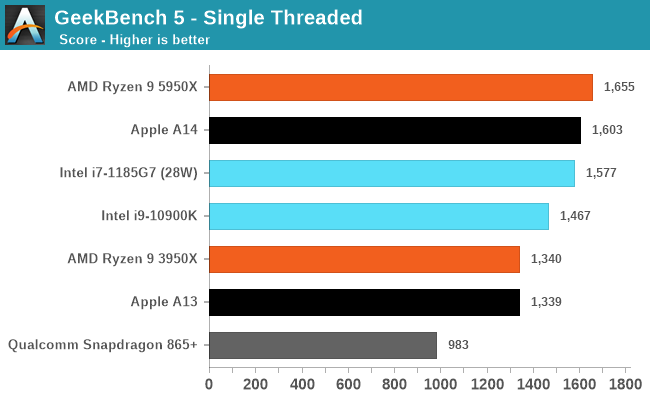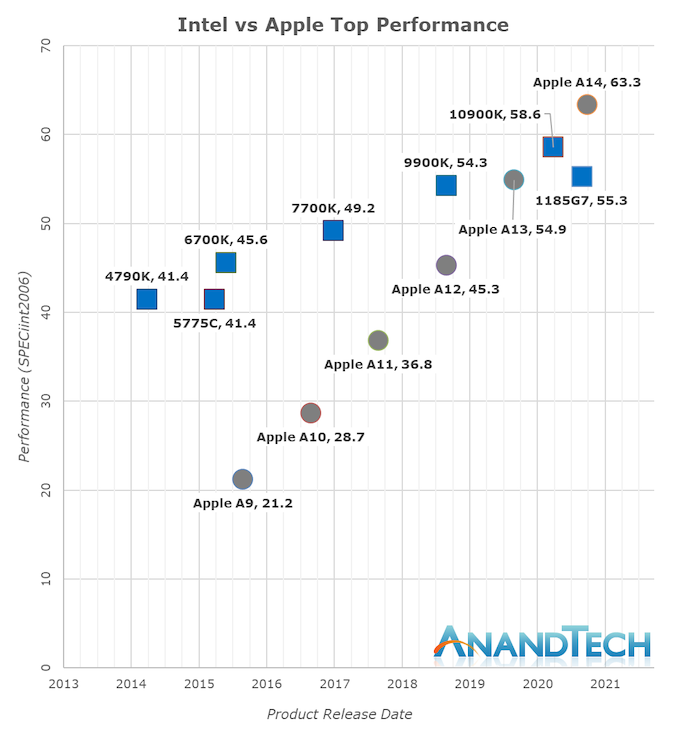Apple Announces The Apple Silicon M1: Ditching x86 - What to Expect, Based on A14
by Andrei Frumusanu on November 10, 2020 3:00 PM EST- Posted in
- Apple
- Apple A14
- Apple Silicon
- Apple M1
From Mobile to Mac: What to Expect?
To date, our performance comparisons for Apple’s chipsets have always been in the context of iPhone reviews, with the juxtaposition to x86 designs being a rather small footnote within the context of the articles. Today’s Apple Silicon launch event completely changes the narrative of what we portray in terms of performance, setting aside the typical apples vs oranges comparisons people usually argument with.
We currently do not have Apple Silicon devices and likely won’t get our hands on them for another few weeks, but we do have the A14, and expect the new Mac chips to be strongly based on the microarchitecture we’re seeing employed in the iPhone designs. Of course, we’re still comparing a phone chip versus a high-end laptop and even a high-end desktop chip, but given the performance numbers, that’s also exactly the point we’re trying to make here, setting the stage as the bare minimum of what Apple could achieve with their new Apple Silicon Mac chips.

The performance numbers of the A14 on this chart is relatively mind-boggling. If I were to release this data with the label of the A14 hidden, one would guess that the data-points came from some other x86 SKU from either AMD or Intel. The fact that the A14 currently competes with the very best top-performance designs that the x86 vendors have on the market today is just an astonishing feat.
Looking into the detailed scores, what again amazes me is the fact that the A14 not only keeps up, but actually beats both these competitors in memory-latency sensitive workloads such as 429.mcf and 471.omnetpp, even though they either have the same memory (i7-1185G7 with LPDDR4X-4266), or desktop-grade memory (5950X with DDR-3200).
Again, disregard the 456.hmmer score advantage of the A14, that’s majorly due to compiler discrepancies, subtract 33% for a more apt comparison figure.

Even in SPECfp which is even more dominated by memory heavy workloads, the A14 not only keeps up, but generally beats the Intel CPU design more often than not. AMD also wouldn’t be looking good if not for the recently released Zen3 design.

In the overall SPEC2006 chart, the A14 is performing absolutely fantastic, taking the lead in absolute performance only falling short of AMD’s recent Ryzen 5000 series.
The fact that Apple is able to achieve this in a total device power consumption of 5W including the SoC, DRAM, and regulators, versus +21W (1185G7) and 49W (5950X) package power figures, without DRAM or regulation, is absolutely mind-blowing.

There’s been a lot of criticism about more common benchmark suites such as GeekBench, but frankly I've found these concerns or arguments to be quite unfounded. The only factual differences between workloads in SPEC and workloads in GB5 is that the latter has less outlier tests which are memory-heavy, meaning it’s more of a CPU benchmark whereas SPEC has more tendency towards CPU+DRAM.
The fact that Apple does well in both workloads is evidence that they have an extremely well-balanced microarchitecture, and that Apple Silicon will be able to scale up to “desktop workloads” in terms of performance without much issue.
Where the Performance Trajectory Finally Intersects
During the release of the A7, people were pretty dismissive of the fact that Apple had called their microarchitecture a desktop-class design. People were also very dismissive of us calling the A11 and A12 reaching near desktop level performance figures a few years back, and today marks an important moment in time for the industry as Apple’s A14 now clearly is able to showcase performance that’s beyond the best that Intel can offer. It’s been a performance trajectory that’s been steadily executing and progressing for years:
Whilst in the past 5 years Intel has managed to increase their best single-thread performance by about 28%, Apple has managed to improve their designs by 198%, or 2.98x (let’s call it 3x) the performance of the Apple A9 of late 2015.
Apple’s performance trajectory and unquestioned execution over these years is what has made Apple Silicon a reality today. Anybody looking at the absurdness of that graph will realise that there simply was no other choice but for Apple to ditch Intel and x86 in favour of their own in-house microarchitecture – staying par for the course would have meant stagnation and worse consumer products.
Today’s announcements only covered Apple’s laptop-class Apple Silicon, whilst we don’t know the details at time of writing as to what Apple will be presenting, Apple’s enormous power efficiency advantage means that the new chip will be able to offer either vastly increased battery life, and/or, vastly increased performance, compared to the current Intel MacBook line-up.
Apple has claimed that they will completely transition their whole consumer line-up to Apple Silicon within two years, which is an indicator that we’ll be seeing a high-TDP many-core design to power a future Mac Pro. If the company is able to continue on their current performance trajectory, it will look extremely impressive.











644 Comments
View All Comments
chlamchowder - Friday, November 13, 2020 - link
Thunder X3 is dead by the way. Marvell cancelled it. The team got laid offtrini00 - Thursday, November 12, 2020 - link
With Intel owning all x86 patents and not really enjoying competition or business with less than 40% margin its not so likely. Intel would rather sell off their CPU business like their ram business, phone business, modem business, 5g business etcTeckk - Wednesday, November 11, 2020 - link
It was Intel till now that was the limit for 16 GB RAM and now it’s Apple, releasing a new laptop in 2020 with the limit. Great.techconc - Wednesday, November 11, 2020 - link
Yeah, that's definitely a black mark from my perspective. I think it's criminal to ship a Mac with 8GB in 2020. The minimum should be 16GB and lower end machines such as those announced this week should have at least an option to go to 32GB. Let's hope Apple rectifies this problem with the iMac, and 16" MacBook.alysdexia - Wednesday, November 11, 2020 - link
I don't need more than 8 GB but still like Mac; fuck off.techconc - Thursday, November 12, 2020 - link
Maybe you should pull up your Activity Monitor and see how much memory you're using now before making additional ignorant comments.GeoffreyA - Wednesday, November 11, 2020 - link
As much as I hate to say it, this is impressive work from Apple. Besides the scores, where a 5W A14 is on the heels of 105W Zen 3, leaving me dumbfounded, the chart showing yearly execution is striking. 10/10.Anyhow, this isn't some "debunking" of Intel/AMD and x86. Yes, the former are carrying the weight of x86 decoding, which is where a lot of power gets eaten; and their cores are narrower but going for higher frequency. But I'm confident that, if they used the M cores as a measure, they would wake up and ramp up their own cores, or, if push comes to shove, even design an ARM one, and give Apple a run for its money round the Park.
GeoffreyA - Wednesday, November 11, 2020 - link
As for the ARM-taking-over debate, how it will go remains to be seen and depends on Windows. Firstly, even if M1 is the best CPU in the world, these and future Apple cores will never go into ordinary (non-Apple) computers. Which means other ARM CPUs, if they want to take over, will have to beat Ryzen/Core on Windows---and this is assuming Windows on ARM is running x86-64 perfectly (presently it lacks x64 emulation but Microsoft will be implementing it soon). Now, AMD and Intel can extend their cores to knock those other fellows down; and even if they couldn't do it on x86 any more, I'm confident they could implement the ARM ISA and thrash the others, including Apple. Nvidia will play a part (a dirty part?) in this picture too.What might happen is a transition period, where we've got both Windows x86 and ARM running side by side (cf. x86-64 in the 2000s). Assuming software works transparently, people could build a computer with, say, a MediaTek CPU or stick with Ryzen on x86. Then, somewhere along the line, Intel and AMD release their own top-performing ARM cores and eventually phase out x86. Now, being old-school, I hope none of this happens and x86 wins the day.
Silver5urfer - Wednesday, November 11, 2020 - link
Look at what AMD CEO Lisa Su mentioned, when asked for ARM vs x86, she said x86 remains their focus and innovation left to be done there. And recently Intel started doing Big Little garbage (why would a desktop S series unlocked TDP processor with high clocks want a slow x86 core ? ) for Alder lake and they even screwed up their own AVX512 on that, as small cores won't be able to do that.Moving to AMD again, they mentioned they are not going for this route and that is not some miraculous route either, saying it has been there since a long time, which is true. And they are not chasing that idiotic biglittle in PCs.
Man one has to understand what is this benchmark about, people are parading x86 is dead. The benchmark has to be taken like this..
5W for an M1 core on TSMC 5nm doing the work of SPEC and GB workload is almost same as 50W (no idea why the 1Core is 60W for Ryzenb 5950X btw since their max TDP is 105W and it stays very efficient unlike Intel MCE) for 1 x86 Ryzen core of Zen3.
what about the other 15Cores and 32 Threads ? same for Apple's other 7 big cores and 8 small cores. What about the combined performance, it's not like this is first time Apple did something, A13 CPU was also fast by previous articles but did it materialize in a Mac ? no only this.
Now the Software package, do we have anything to compare both on a Mac ? I think we will have to wait until Adobe optimizes their Software for ARM based Mac OS, because Apple paid them to do so and until that we won't know, so we will have to wait for Steam running on the same H.W and then we need to wait for other software and etc, and until then one cannot determine the winner.
This article is giving false impression based on the benchmarks how they are carried out and compared with. On top there's no VM in this new Mac afaik, they threw whole Bootcamp out of Window, adding extra VM is a pain for them and so no more Linux nor Windows on this H.W, this is a mega closed box, even HW is soldered heavily.
x86 is still leader, AMD as of today has 6.6% of Servermarket share and Intel has over 92%. That added with Consoles running x86 Hardware and vast majoriuty of the PC running x86 H.W barring a stupid Surface Pro X.. And Macs account for 9-10% of marketshare as well..
GeoffreyA - Wednesday, November 11, 2020 - link
Great comment. I'm in 100% agreement. The point about a single core of Ryzen and the TDP escaped me, and that changes the whole picture. Also, lower Ryzen's clocks, drop it down to 5 nm, and suddenly Apple isn't looking too shiny any more, and its gigantic ROB, PRFs, etc., begin to look pretty overblown and silly.